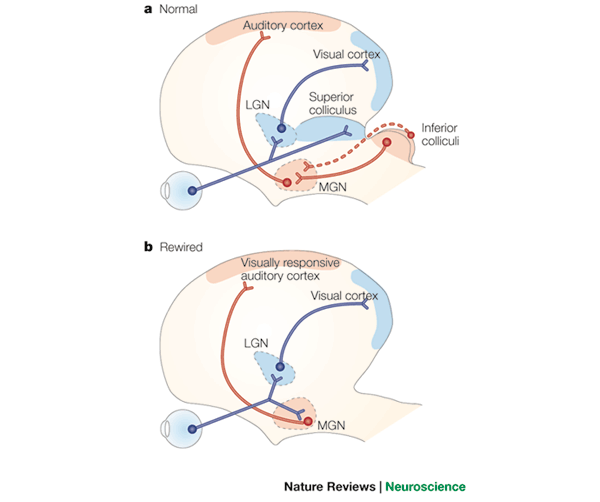PSYC 170 - Summer 2013 - Professor Claffey
Notes: Damage
PDF__________ - localized damage, typically associated with a change in function/abilities
sometimes a literal hole - neurons die, area fills with cerebrospinal fluid
Cerebrovascular Disorders
problems with blood flow to the brain_________
cardiopulmonary failures (heart attacks), near-drowning, strokes, carbon monoxide
generally 4-6 minute can result in permanent damage
sleep apnea can reduce blood oxygenation from 95% to ~50%
_________________
swelling of the ventricles due to blockage of cerebrospinal fluid
swelling can disrupt blood flow and distort tissue
Stroke
U.S. Statistics
- ~800,000 per year
- 3rd leading cause of death (140,000 people per year)
- leading cause of adult disability
- average age: 70 years old (75% of stroke victims over 65 years old)
- Source: strokecenter.org
routes of harm:
- anoxia/hypoxia to affected tissue
- intracranial pressure and distorted tissue
- compromise of blood-brain-barrier
______________ - the area of dead/damaged tissue
cerebral ____________________
rupture of blood vessels
balloon like expanse in an
artery: ____________________
cerebral ____________________
disruption of blood flow
thrombosis - a plug or clot that develops in
place
embolism - a plug or clot that breaks free, travels through blood stream, lodges elsewhere
arteriosclerosis - narrowing of arteries by fatty plaques
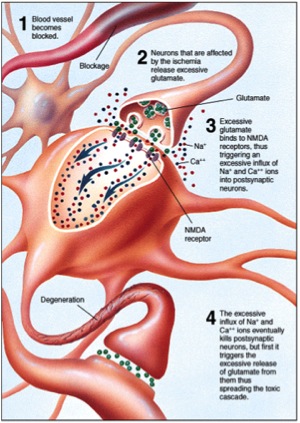
|
ischemic cascade disruption of oxygen delivery causes energy crisis & failure to maintain cell homeostasis fail to: ______________________ internal build up of Na+, permanent depolarization, glutamate release fail to: clean up ____________________ cell metabolism is catastrophically altered by _______ some areas more sensitive than others: hippocampus |
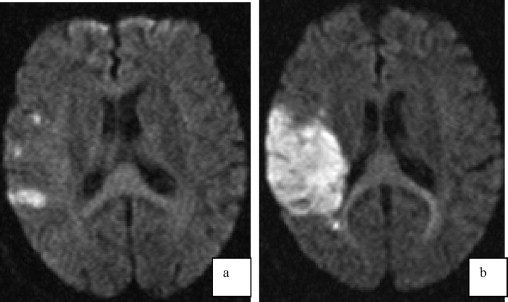 a) 4 hours after symptoms, b) 1 week after symptoms Source: Weis-Müller et al, 2007 |
Diagnosing ________ imaging - detect round, clean edge lesions of uniform density, noninvasive _____________ - inject contrast dye into venous/artery system, more detailed but invasive |
Intracranial Tumors
morbid, uncontrolled growth of tissue
brain tumors make up 5% of all cancers
most common in early and middle adulthood
because CNS neurons do not typical undergo mitosis (reproduce),
tumors usually do not originate from neurons
_____________ (from "glial" cells)
infiltrative tumors
difficult surgery, unlikely to remove completely, often reoccurring
40-50% of brain tumors
Benign (left) vs malignant
(right) tumors Source: www.mayfieldclinic.com/PE-BrainTumor.htm |
____________________ (originating in the meninges) usually benign, wrapped in a membrane easier to surgically remove slow growing, can become quite large cause problems by displacing tissue, but brain can sometimes adapt for years about 15-20% of brain tumors |
________________
originating from elsewhere in the body
typically closer to cortical surface but can be anywhere
difficulty surgery, poor prognosis because already spreading
15% of brain tumors
pituitary tumors
pituitary gland is a major interface between nervous and endocrine system
can result in excessive growth hormones, resulting in giantism
15% of brain tumors
symptoms: headaches, nausea, seizures, disruption of cognitive function
has effects by disrupting neural tissue, vascular compression, endocrine interference
typically diagnosed using CT or MR imaging
Traumatic Brain Injury (TBI)
U.S. Statistics
2 million per year
4th leading cause of death (1st in persons aged 1-44 years)
50% of trauma deaths are secondary to TBI (35% of these gunshot wounds)
92% mortality rate for gunshot wound
Source: Vinas & Pilitis, 2006
________ head injury
penetration of the skull
death typically caused by disruption of blood flow (ischemic cascade)
_________ head injury
impact or sudden acceleration, but skull was not fractured
adolescents & young adults: accidents, defuse damage
65 and older: falls, focal damage
Closed Head Injuries
____________________
a "mild" TBI
altered consciousness for 2-30 minutes
no
evidence of vascular damage
symptoms: cognitive, somatic (dizzy, nausea), emotional
not considered a medical event until ~1980s
increasing awareness of potential for long term damage, especially with repetition
Damage
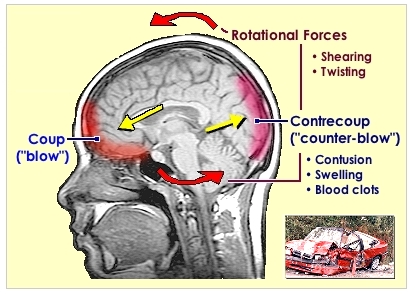 |
____________________ of axons damage is not immediate subsequent neuron death difficult to detect with imaging over long term, shows up as decreased volume (enlarged ventricles) ______ - at site of impact countrecoup - opposite of impact, due to rebound most common in frontal and temporal lobes |

|
____________________ - damage to circulatory system _________ ___________ |
Symptoms
loss or altered consciousnessGlasgow Coma Scale - assess eye opening, motor response, verbal response
low scores 6 hours after injury indicates 35-50% chance of death within 6 months
post-traumatic anterograde amnesia
difficulties forming new memories
lasting longer than 3 weeks indicates poor prognosis
difficulties with divided attention, behavioral control, planning, abstract planning
Sports Related Injuries
football, boxing, rugby, horseback ridingdementia pugilistica
tremors, difficulty speaking, abnormal reflexes
related to the number of matches (Mortimer & Pirozzolo, 1985)
subtle but long-term cognitive differences
number of concussions (ranging from 0-7) in amateur soccer players was inversely correlated with
performance on planning and memory tests
Matser et al, 1999
rugby players with single mild head injury (<20 minutes of altered consciousness, amnesia < 24 hours)
changes in visual attention task still present 1 year later
Cremona-Meteyard & Geffen, 1994
Other
Infection
_____________________ - inflammation of brain due to the invasion of a microorganism
bacterial - syphilis, Lyme disease, malaria
viral - rabies, mumps, herpes encephalitis
cause deficits by interfering with cell function and producing an inflammatory response
Toxins
Drugs: alcohol, marijuana, LSD, MDMA
Difficult to disambiguate neurological effect of the drug from:
cognitive deficits associated with a person's increased likelihood to take drugs
cognitive deficits associated with risky or neglectful drug-related behaviors
Lead, organic solvents, pesticides (organophosphates)
Some improvement after leaving harmful environment, but usually lasting effects
Neuron damage & regeneration
____________________ - the ability of neuron configurations, and therefore the brain, to change with time and recover
critical to development, learning and recovery
Damage
____________________
programmed cell death
slow, orderly disintegration of cells, no inflammation, doesn't disturb neighboring cells
(Full review: Apoptosis in neurodegenerative disorders, Nature Reviews Mol Cell Bio, Mattson 2000)
____________________
sudden, disorderly cell death
causes inflammation, disrupts neighboring cells
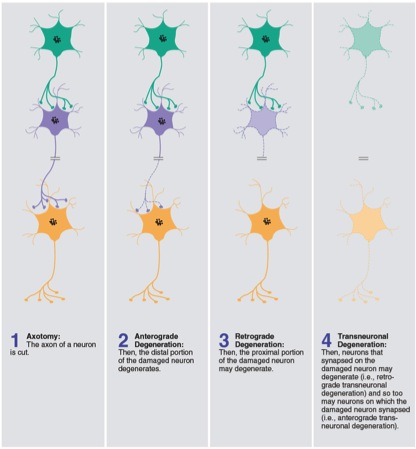
|
_____________________ degeneration damage between cut and synaptic terminals this is the distal portion of the neuron _____________________ degeneration damage between cut and cell body this is the proximal portion of the neuron _____________________ degeneration when a neuron dies, other neurons that are post-synaptic, or pre-synaptic may also die |
Regeneration
Unsuccessful in mature mammals and higher vertebratesCNS - virtually non-existent
PNS - unlikely but possible
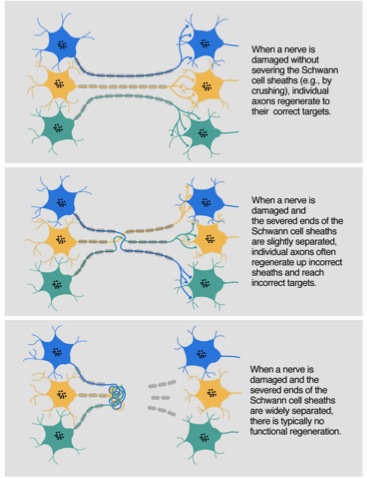
|
Regeneration in PNS requires original _________________________ to be intact neurotropic factors - chemicals that encourage tissue growth CAMs - cell adhesion molecules, provide guidance new growth may connect to incorrect targets It is not the neurons themselves, but the environment CNS neurons transplanted to PNS will regenerate PNS neurons transplanted to CNS will not regenerate |
Reorganization
Example 1: Reorganization in V1 following retinal lesions
In adult monkeys, remapping can occur within hours (Botelho et al, 2012)
Example 4: Phantom limb
somatosensory cortex that previously received input from amputated arm begins responding to neighboring input
Example: touching a patient's cheek can feel like touching the amputated arm
Treatment & Recovery
____________________ - return of original
function in a damaged area
Example: after a stroke affecting the hand motor area, that tissue recovers and hand function returns
____________________ - performing a function by newly learned methods using
non-damaged areas
Example: after a stroke affecting the hand motor area, neighboring tissue learns to operate the hand
1. Reducing degeneration
apoptosis inhibition
nerve growth factors
estrogen (Review: Brann et al, 2007)
females have better incidence/outcomes in neurological pathologies
administration of estrogen improves post-stroke outcomes in rodents
2. Promoting regeneration
can be induced in CNS neurons by Schwann cells (Xu et al, 2004)
physical activity promotes adult neurogenesis in rodent hippocampus
3. Transplant
fetal substantia nigra cells for treating monkeys with Parkinson's disease-like symptoms
limited success with humans
embryonic stem cells in rat damaged spinal cord improved mobility
4. Rehabilitative training
for hands, restrict the functioning limb to maximize use of impaired hand
for spinal cord injuries, facilitated walking
